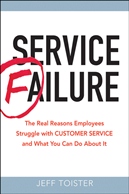Debunking the myth that attitude is a choice
 Jeff Toister
Jeff Toister  Wednesday, January 9, 2013 at 6:32AM |
Wednesday, January 9, 2013 at 6:32AM | You may have heard the story about a Subway employee who lost his job after getting into a confrontation with a customer over ketchup. The short version of the story is a customer ordered a Philly cheesesteak sandwich with ketchup and an argument ensued when the employee insisted that Subway didn’t have ketchup. It nearly escalated into a physical altercation and the police were eventually called to the scene.
It’s tempting to look at the situation and conclude that the employee chose the wrong attitude.
If only it were that simple.
The truth is our attitudes can be trigged by involuntary or even unconscious emotions. Yes, there are still choices involved, but the choice is what we do next once we recognize these sour emotions within ourselves. The Subway employee lost his job because he didn’t make the right decisions once his bad attitude emerged.
Emotional Hijacking
I interviewed a nightclub employee named Paul while writing my book on hidden obstacles to customer service. One of the stories he shared was a telephone encounter with an angry customer who called to accuse a server of stealing his credit card number. Despite years of experience in hospitality, Paul found himself struggling with his emotions:
“I could feel my blood pressure going up. I could feel my face get flush. I felt like, ‘Don’t accuse my co-worker of doing something that you don’t know that they did.’ There was a million ways that credit card numbers get stolen. It was so frustrating to me.”
Paul knew the right thing to do was to project a calm and empathetic demeanor, but he struggled with this common sense because his emotions were running high. The customer’s pointed accusations caused Paul to experience what’s called an emotional hijacking, a situation where the emotional center of our brain becomes so consumed with powerful emotions that it temporarily takes over our ability to reason.
Unlike the now infamous Subway employee, Paul made the correct decision once he was aware of his negative emotions. He reminded himself to stay calm, took down the customer’s information with a promise to look into it, and quickly got off the phone before he lost his cool.
Unconscious Emotions
As hard as it may be to believe, there are times when we aren’t consciously aware of the emotions we are experiencing. In his book, Working with Emotional Intelligence, Daniel Goleman likens this to a “social virus” where emotions are spread undetected from person to person.
These unconscious emotions can negatively affect a person’s body language and tone of voice. These are two of the most important ways we communicate our attitudes to others, so a customer service employee who is “infected” can signal customers that they are in a bad mood without fully being aware they feel this way.
Viewed from this perspective, expecting a customer service employee victimized by unconsciously communicated emotions to remain happy and upbeat is like trying to avoid getting the flu. You can take precautions to guard against it, but there’s no guarantee that you won’t be infected.
Fortunately, both positive and negative emotions can be unconsciously contagious. Positive employees naturally cause their co-workers to quickly recover from negative emotions. Happy customers also influence the people who serve them to do better. Of course, it also doesn’t hurt to provide great products and services backed by customer-friendly policies that are less likely to create angry customers in the first place!
Conclusion
It can be a challenge for customer service employees to effectively manage their emotions, but it gets even more difficult when all they get from their supervisor is an admonition to avoid taking it personally. Employees need coaching and encouragement to continuously project the positive attitude their customers expect.




